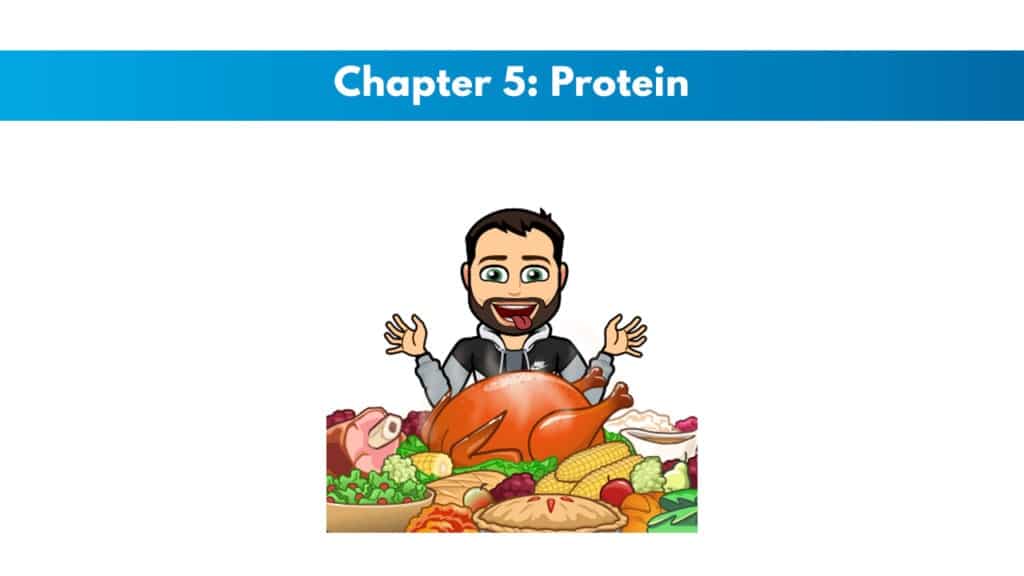
If you have not yet signed up for the ISSA Nutritionist certification, you can get it here for free as part of a special bundle.
Get your copy of the ISSA Nutritionist exam cheat sheet. It helps immensely for studying for the exam.
Make sure to check out Trainer Academy for premium ISSA Nutritionist study materials. They will reduce study time by 50% and have an exam pass guarantee. Read my full review on them here. You can save $100 on their MVP study system with the code: PTPSUB
Chapter Goals:
- Be able to define the key terms related to protein and amino acids.
- Know how to explain protein and amino acids’ functions and physiological effects within the body.
- Know the differences between essential and nonessential amino acids.
- Know the digestion and absorption processes for proteins in the body.
Introduction
Protein is possibly our most vital macronutrient and has a clear role in health and fitness.
Studies have shown that diets too high in protein may be just as detrimental as diets lacking in protein. It is also a fact that active people need to intake more protein than more sedentary people.
Some of the roles played in the diet by protein are that of provision of structure and growth, the catalyst for reactions, signaling, support for the immune system, and activity in it—transportation across the cell membrane.
Proteins are not a primary energy source but may be used as a last resort during intense exercise and when nutrition is not up to par.
Protein
Proteins are macromolecules and polypeptides, compounds with 10 – 100 or even more molecular subunits. Each subunit will be a small molecule, an amino acid linked by a peptide bond.
There are four levels of structure within each protein, and the shape of the protein will give information regarding its role and function in the body.
The unique amino acid sequence of the polypeptide chain is determined through genetics to make the primary structure.
The local folding for polypeptide chains makes the secondary structure.
Combinations of chains and sheets then make up the protein’s shape. We consider the 3-d shape of the polypeptide to be the tertiary structure.
Some proteins comprise several polypeptides, which we know as subunits.
The amino acids are the main structure creating a secondary helix.
It is important to consider the amino acids rather than the entire protein for nutrition.
There are 20 amino acids that we consider to be biologically important, but many more of them exist in nature and the body. These amino acids are the building blocks for protein and their individual bodily roles.
Every amino acid is made up of one central carbon atom, which is called alpha carbon. Bonded to this alpha carbon are these:
- An amino group
- A carboxyl group
- A hydrogen atom
- The R group
When amino acids attach to each other through covalent bonds, they form peptides. These are formed through a dehydration reaction, so water is removed.
The Role of Protein in the Body
Protein is required for the growth, maintenance, and repair of cells, like muscle cells; for the production of the enzymes and hormones used in the body; and for the expression of DNA.
Proteins exist in a wide range of shapes and sizes and we divide these into simple and conjugated categories.
Proteins may fill these roles:
- Contractile
- Hormonal
- Structural
- Transporter
- Enzymes
- Receptor
Amino Acids
Naturally, amino acids are classified based on their dietary needs in the body.
The essential amino acids cannot be manufactured in the body and then must come from the diet. Nonessential amino acids can be made in the body.
Exclusive PTP CPT Offers |
||
|---|---|---|
Gold Standard Cert | Most Popular Cert | Best Study Materials |
A Good Option | A Good Option | Best CPT for you?  |
Like most things in the diet, our protein sources must be varied and include the right proportions of nutritionally important amino acids.
Amino Acid Review
Some amino acids act as components of proteins, and then others have expanded functions as biochemical intermediates or precursors of other amino acids.
Alanine
This is a nonessential amino acid that we find in high amounts within our muscle tissue and it plays a role in the glucose-alanine cycle when the body is low on other fuel sources.
Arginine
This nonessential amino acid is vital in stimulating the release of GH and insulin-like growth factors.
Asparagine
This is a nonessential amino acid that is involved in the proper function of the CNS.
Aspartic Acid
This can be referred to as L-aspartic acid or L-aspartate, and it is a nonessential amino acid that is used to help reduce the levels of ammonia in the blood post-exercise.
Branched Chain Amino Acids
These include the amino acids of isoleucine, leucine, and also valine.
Together are three amino acids that comprise 35% of the amino acids within the muscle cells, and they can be used as energy by the body. The body utilizes these amino acids during high stress, injury, or exercise.
Some benefits of these branched-chain amino acids as a supplement include:
- Increases in endurance during exercise
- Reduction in the fatigue associated with exercise
- Improvements in mental performance
- Increased levels of energy
- Stimulation of protein synthesis
- Improvements in the function of the immune system
- Increases in the levels of lean body mass
- Increases in overall strength
Citrulline
This nonessential amino acid plays a role in the urea cycle to remove the ammonia in the blood.
Cysteine
This is a nonessential amino acid that bears sulfur and plays a vital role in energy production, and may be used to manufacture methionine and serine.
Glutamic Acid
This may also be known as glutamate, and it is a nonessential amino acid that acts as an intermediary in the Krebs cycle and is vital for its uses in carb metabolism.
Glutamine
This is one of the most plentiful nonessential amino acids in the body. People under stress from disease or injury may have decreased levels of this amino acid.
Glycine
This is a nonessential amino acid that is made from serine, and it is important for many types of substances within the body, like protein, DNA, phospholipids, collagen, and creatine.
Histidine
Exclusive PTP CPT Offers |
||
|---|---|---|
Gold Standard Cert | Most Popular Cert | Best Study Materials |
A Good Option | A Good Option | Best CPT for you?  |
This essential amino acid is needed for the important in growth and repair of human tissues.
Isoleucine
This essential amino acid is needed mainly for forming the hemoglobin in the body.
Leucine
This essential amino acid is important in the production of energy when exercising.
Lysine
This essential amino acid is found in large amounts in the muscle tissue and is primarily used for growth and repair.
Methionine
This is an essential amino acid that is involved in transmethylation.
Phenylalanine
The essential amino acid is a precursor of the nonessential amino acid tyrosine.
Proline
A nonessential amino acid found in great amounts in collagen can be made easily from glutamic acid.
Serine
This is a nonessential amino acid we find in proteins and it is derived from glycine. It works to form many vital substances.
Taurine
This nonessential amino acid plays a major role in the brain tissues, the functioning of the nervous tissues, regulating blood pressure, and transporting electrolytes across the cell membrane.
Threonine
This is an essential amino acid, and it is important for collagen, tooth enamel, protein, and elastic tissues.
Tryptophan
This essential amino acid is needed to produce vitamin B3 and the neurotransmitters serotonin and melatonin.
Tyrosine
This nonessential amino acid is made from phenylalanine and is a foundation for thyroid hormones.
Valine
This is an essential BCAA and is integral for muscle tissues, and may be used for energy.
Proteins, Amino Acids, and Energy
In times of severe restriction of calories, the body will release some amino acids to keep providing energy for activity.
Even when well-fed, the body sometimes uses proteins for energy, even at rest.
The body can utilize the three BCAAs for energy during exercise, but it uses leucine most of all.
The Quality of Proteins
Not all proteins will be equal nutritionally for ideal growth in children.
Complete proteins are going to be proteins with all of the essential amino acids in the proper amount needed for the growth and maintenance of the body.
Incomplete proteins are deficient in one or more of the essential amino acids.
Free-form and Peptide-bonded Amino Acids
- The terms free-form and peptide-bonded are often used to describe the amino acid content of food or supplements.
- Peptide-bonded amino acids are amino acids that are linked together.
- Dipeptides are two amino acids linked together.
- Tripeptides are three amino acids linked together.
- Polypeptides are four or more amino acids linked together.
Protein Digestion
Several factors are changing a protein’s shape and chemistry.
Changes in temperature, pH, high salt concentrations, alcohol, mechanical agitation, and exposure to chemicals alter the shape of a protein.
Mouth to stomach
Chewing will break down the larger protein chunks into smaller pieces that can then be swallowed. None of the enzymes in saliva will act on protein.
In the stomach, the gastric juices will break down protein further. The acidity will unfold some of the parts of proteins.
Pepsin is secreted in the stomach lining to break the peptide chains into shorter fragments.
Small intestine to the bloodstream
Most protein digestion happens in the small intestine with the use of protease.
Chyme enters the small intestine at the entrance of chymotrypsin and trypsin.
Transport proteins using the energy from ATP move the amino acids through the intestinal cells and to the blood to be sent to the liver before being sent to the other cells or breaking down further.
Food Sources of Protein
Proteins are found in animals and plants, and protein and fat are usually found together, especially in animal products.
Most animal proteins tend to be higher in quality than plant proteins.
Protein and Athletes
Athletes typically need a diet that is protein high since they place a high demand on their bodies.
Differing types of exercise and intensities will require this protein in varying amounts.
Nutrition coaches should work to consider a few things when making their protein suggestions for their athletes.
Protein can be broken down and used to store as fat.
For the building of lean muscle mass, daily protein intake must maintain a positive protein balance.
Carb intake can also help to offset the damage to muscles and the promotion of recovery via insulin and its downstream effects on the MAPK pathway, which is a chain of proteins in the cell that communicates a signal from a receptor on the surface of the cell to the DNA in the nucleus of the cell.
In most nutrition plans, fitness professionals should prioritize whole foods for protein and likely include supplemental proteins for athletes if needed.

 Have a question?
Have a question? 


![ISSA Bodybuilding Specialist Review ([year]) Update 9 ISSA Bodybuilding Specialist Certification - bodybuilding coach pressing overhead under coach supervision](https://www.ptpioneer.com/wp-content/uploads/2024/04/ISSA-Bodybuilding-Specialist-Certification.png)
![ISSA Strength & Conditioning Coach Certification Review ([year]) 10 ISSA Strength and Conditioning Certification Review featured image](https://www.ptpioneer.com/wp-content/uploads/2023/03/issa_strength_and_conditioning_certification_review.jpg)
![ISSA Corrective Exercise Specialist Certification Review ([year]) 11 ISSA Corrective Exercise Specialist Review](https://www.ptpioneer.com/wp-content/uploads/2023/02/issa_corrective_exercise_specialist_review.jpg)

![ISSA Exam Prep [year] - How to pass the ISSA Exam On Your First Try 14 ISSA Exam Prep](https://www.ptpioneer.com/wp-content/uploads/2022/12/ISSA-Exam-Prep-1.jpg)


Tyler Read
PTPioneer Editorial Integrity
All content published on PTPioneer is checked and reviewed extensively by our staff of experienced personal trainers, nutrition coaches, and other Fitness Experts. This is to make sure that the content you are reading is fact-checked for accuracy, contains up-to-date information, and is relevant. We only add trustworthy citations that you can find at the bottom of each article. You can read more about our editorial integrity here.